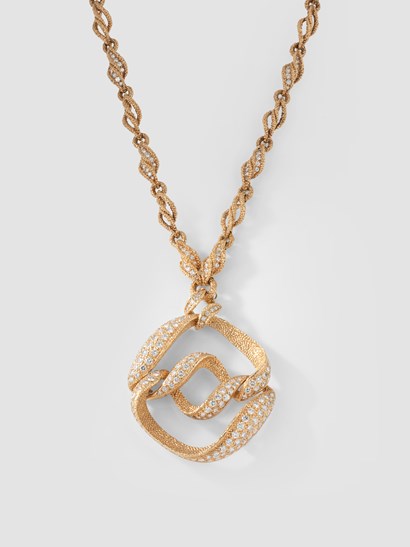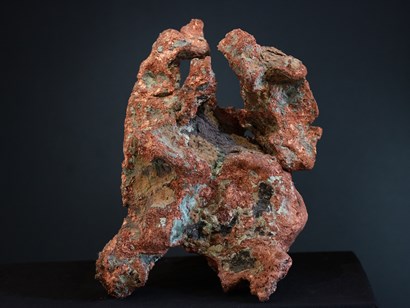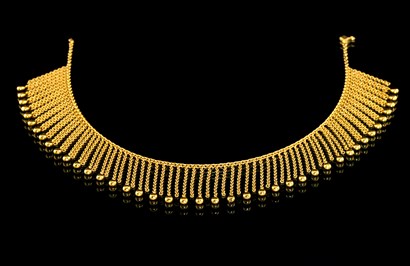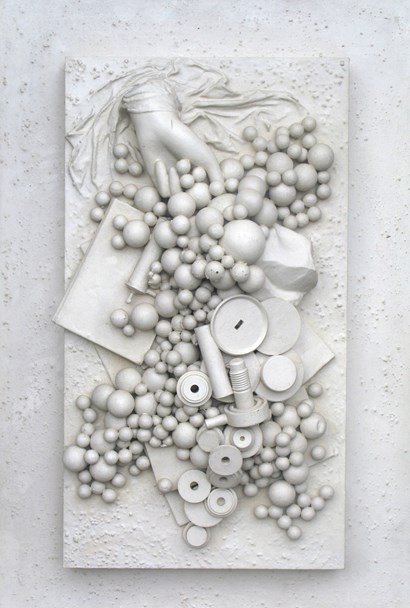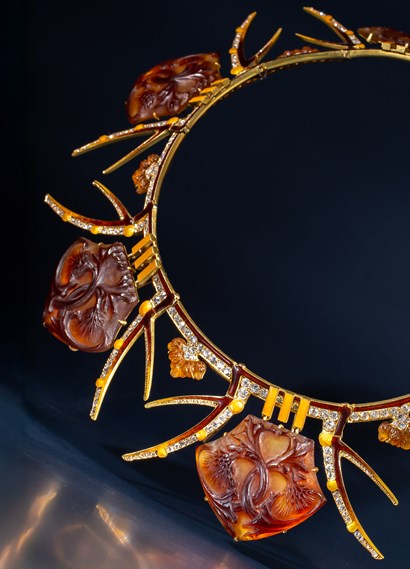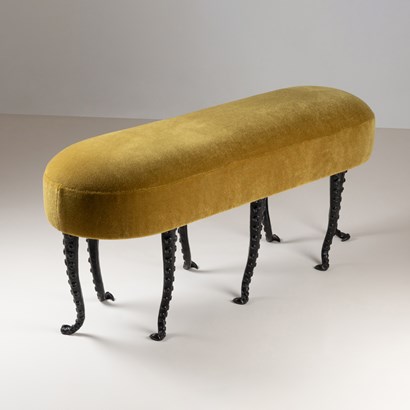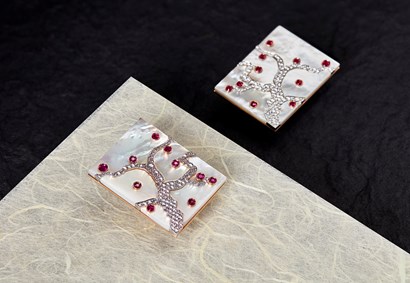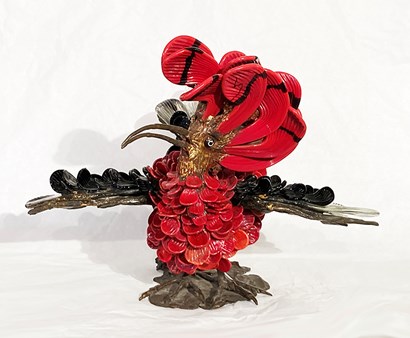This section will be available this Autumn.
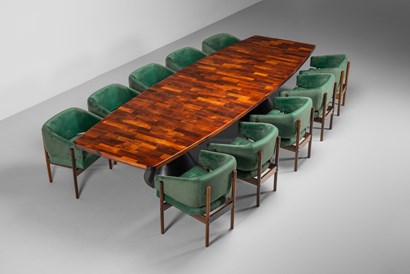
MassModernDesign
jorge zalszupin
Jorge Zalszupin (Warsaw 1922-2020 São Paulo) Guanabara table and Senior chairs, 1960 Rosewood, leather, velvet upholstery H 75 x W 400 x D 130 cm (table) Produced by l'Atelier, Brazil Provenance: private collection, São Paulo Literature: Jorge Zalszupin, Modern Design in Brazil Maria Cecilia Loschiavo dos Santos 2014, pp. 142-143
_ChristoandJeanne-Claude_T638932180913780762.jpg?width=410&height=2000&qlt=90&scale=both&mode=max&format=jpeg)
Edouard Simoens Gallery
christo and jeanne-claude
Christo (Bulgaria 1935-2020 New York) and Jeanne-Claude (Casablanca 1935-2009 New York) The Pont Neuf Wrapped (Project for Paris), 1985 Pencil, charcoal, pastel, wax crayon, and technical data 144 x 165 cm (overall) Provenance: Wolfgang Volz collection; private collection Literature: Christo and Jeanne-Claude: Water Projects, Silvana 2016, p. 167

Kunsthaus Kende
Satoshi Hara (Japan, Yokohama, 1962) Flower vase with inlaid Chrysanthemum design (mujinagiku) Ishikawa, 2018 Gold, silver and iron H 18 cm - Ø 20 cm Provenance: artist’s estate Satoshi Hara, who was born in Yokohama, Kanagawa Prefecture in 1962, specialises in creating hammered metalworks embellished with intricate and labour-intensive decorations in gold and silver. This highly developed inlay technique makes the decorations appear as if they were drawn with a thin pen. The artist has created his own technique, which he calls ‘Nanako Zogan.’ With this technique, he is able to inlay patterns into the vessels using 0.3 mm-thick silver wires. Each individual line is created in five different steps. One piece of work contains an average of 50 metres of silver wire, meaning that the artist has to work with approximately 200 metres of silver wire throughout the various stages. There is no room for error in this highly complex and time-consuming process, since it is impossible to rectify any mistakes. The artist has been teaching metalworking at Kanazawa College of Art, Department of Craft, since 2003. His work can be found in numerous museums in Japan and abroad.
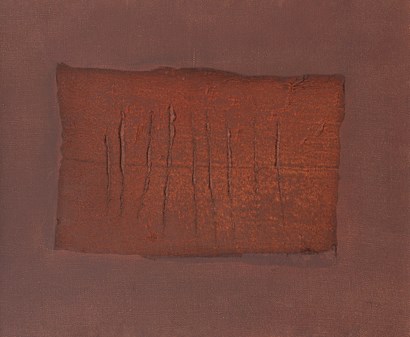
Maurice Verbaet Gallery
Jef Verheyen (Belgium, Itegem 1932-1984 Apt, France) Hommage à Fontana, 1959 Oil, collage on canvas 50 x 60.5 cm Provenance: Hans Liechti, Grenchen; private collection, Switzerland Literature: Willy Van den Bussche and Léonore Verheyen, Retrospective Jef Verheyen 1932–1984 (Ostend/Bruges: PMMK – Provincial Museum of Modern Art / Stichting Kunstboek, 1994), p. 76 Exhibitions: Retrospektive Jef Verheyen 1932-1984, Josef Albers Museum Quadrat, Bottrop, 10 July-4 September 1994; Retrospectieve Jef Verheyen 1932-1984, PMMK Museum voor Moderne Kunst Ostende, 26 March-13 June 1994
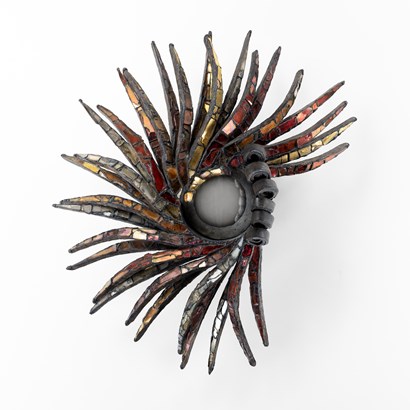
unforget Decorative Arts
line vautrin
Line Vautrin (Paris, 1913-1997) Crète de coq mirror, circa 1965 Talosel inlaid with mirror fragments H 50 x W 41.5 cm Diameter at sight of the central witch: 10 cm This work is accompanied by a certificate of authenticity issued by the Line Vautrin Committee “Crète de Coq”, mirror in black Talosel inlaid with mirror fragments, by Line Vautrin. This convex “witch mirror” features a radiant decoration of incised Talosel inlaid with polychrome mirror tesserae in shades of red, gold, copper, and silver. The spiral composition evokes the bristling energy and dynamic movement of a cockscomb, its form at once organic and architectural. A rare and technically demanding creation, Crète de Coq exemplifies Vautrin’s experimental mastery of Talosel - a material she both discovered and transformed into a medium of pure artistic expression. In this piece, she chose a warm palette of reds, oranges, golden ambers, and bronzed tones, creating a striking contrast with the deep black of the Talosel structure. The frame itself unfolds in six spiraling curves, each extending into a series of radiant, gently curved points that seem to shimmer and vibrate with light. Singular within her oeuvre, this asymmetrical spiral composition differs from Vautrin’s more familiar series, revealing her ability to reinvent form and rhythm through subtle variations. Crète de Coq is not merely a mirror, but a luminous, poetic sculpture - an enchanting testament to Line Vautrin’s imagination and her genius for turning humble materials into magical, living art.
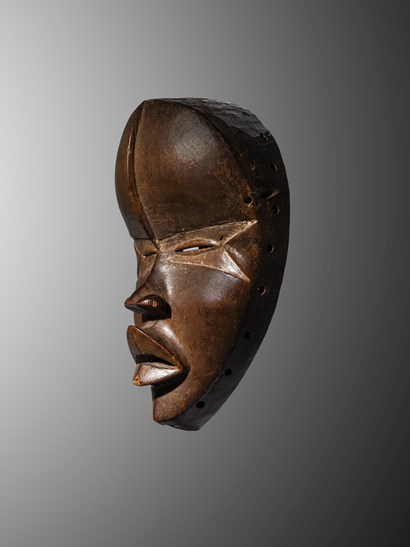
Claes Gallery
Dan 'deangle' Mask Ivory Coast, Dan people Presumed early 20th century Wood and pigment H 25 cm Provenance: Hubert Goldet (1945–2000), Paris, until 1972; Lucien Van de Velde (1933-), Antwerp, from 1972 to 1975; René (1901-1998) & Odette (1925–2012) Delenne, Brussels Literature: Arts d’Afrique Noire 34, 1988, p. 49; Utotombo, Kunst uit Zwart-Afrika in Belgisch privé-bezit, de Heusch, Brussels, 1988, p. 148, fig. 59; A ‘Harley Mask’ at the Cleveland Museum of Art: More on Masks among the Mano and Dan Peoples, Petridis, African Arts, Vol. 45, n° 1, 2012, p. 31, fig. 8; Trésors de Côte d’Ivoire, Neyt, Fonds Mercator, Brussels, 2014, p. 44-45, fig. 18 (indication: H. 26 cm); The Language of Beauty in African Art, Petridis, The Art Institute of Chicago, 2022, p. 207, fig. 164 Exhibitions: Utotombo. Kunst uit Zwart-Afrika in Belgisch privé-bezit, Palais des Beaux Arts, Brussels, 25 March-5 June 1988; The Language of Beauty in African Art, The Art Institute of Chicago, Chicago, 20 January 2022-27 March 2023 Originating from the northwest of Côte d’Ivoire, near the borders of Liberia and Guinea, the Dan are an agricultural people who primarily cultivate rice and cassava. Their way of life, complemented by hunting, fishing, and gathering, is rooted in a patrilineal society without a central authority, structured around clans led by chiefs chosen for their prestige, bravery, or agricultural success. Relations between clans, often marked by rivalries, gave rise to a rigorous social organization: young warriors ensured the group’s defense, while chiefs reinforced their influence through feasts and gifts. Local power rested on a balance between the chief, the council of elders, and the male associations, which upheld discipline, guided the initiation of young men, and preserved community cohesion. The Dan distinguish between two worlds: that of the village - a humanized and social space - and that of the forest, the realm of spirits and natural forces. It is within this duality that their art takes root, renowned for its independence and for the diversity of its styles from one village to another. In their pursuit of formal perfection, Dan artists express through their works an ideal of beauty that is both spiritual and harmonious. A symbol of this aesthetic quest, the Dan 'deangle' mask is characterized by its regular oval shape, polished surface, narrow eyes, short nose, and full, slightly parted lips. The raised scarifications emphasize the geometry and graphic strength of the composition. Of an elegance imbued with softness and femininity, it embodies the Dan ideal of beauty. Used within the Leopard secret society (go), associated with the pacifying spirit zlan, this mask served as an intermediary between young initiates and the village community. First exhibited and published for the general public in 1988, this exceptional work was most recently presented (in 2022) at the Chicago Museum. The mask’s deep gaze, highlighted by a fine band across the eyes, captures the viewer’s attention. Its patina, with warm brown reflections, and its concave form lend it a presence that is both powerful and serene.
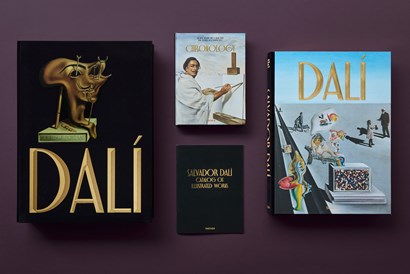
TASCHEN
salvador dalí
Salvador Dalí (Spain, Figueras 1904-1989) Dalí. BABY SUMO This collector’s edition of 10,000 numbered copies presents Salvador Dalí’s work in unprecedented size and detail and is accompanied by a chronology following his path from Catalonia through Paris to Hollywood and back, with photos, sketches, and magazine pages.
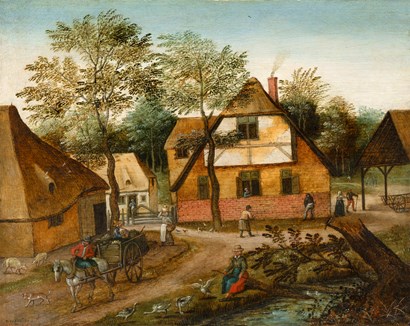
Pelgrims de Bigard
pieter brueghel the younger
Pieter Brueghel the Younger (Brussels 1564-1638 Antwerp) A village scene with a horse-drawn cart and a goose keeper Oil on panel 25 x 31 cm Signed lower left 'P. BREUGHEL' Provenance: collection Kaufmann, before 1934; Kunsthandel P. de Boer, Amsterdam, 1934; collection Van Hees, The Netherlands, until 1969; private collection, The Netherlands Literature: P. de Boer, De Helsche en de Fluweelen Brueghel en hun invloed op de kunst in de Nederlanden, exhibition catalogue, Amsterdam 1934, ill. p. 9, p. 32, n° 32; Pantheon, Monatsschrift für Freunde und Sammler der Kunst, München, 1934, XIII, ill. p. 141; P. de Boer, Catalogus van oude schilderijen, exhibition catalogue, Amsterdam, 1940, ill. n° 8; Singer Museum, Modernen van toen 1570-1630, Vlaamse schilderkunst en haar invloed, exhibition catalogue, Laren 1963, n° 53; Georges Marlier, Pierre Brueghel le Jeune, 1969, pp. 417-418, ill. n° 263; Klaus Ertz, Pieter Brueghel der Jüngere (1564-1637/38), die Gemälde mit kritischem Oeuvrekatalog, Lingen 2000, Vol. II, p. 821, ill. n° 667, p. 824, inv. n° E116 Exhibitions: Amsterdam, Kunsthandel P. de Boer, De Helsche en de Fluweelen Brueghel en hun invloed op de kunst in de Nederlanden, 10 February-26 March 1934, n° 32; Amsterdam, Kunsthandel P. de Boer, November-21 December 1940, n° 8; Laren (N.H.), Singer Museum, Modernen van toen 1570-1630, Vlaamse schilderkunst en haar invloed, 15 June-1 September 1963, n° 53

Galerie Flak
Yipwon hook figure Korewori river, Papua New Guinea, 19th century or earlier (C-14 test) Carved wood H 200 cm Provenance: Merrin Gallery, New York; Californian artist Tony Berlant collection; acquired from the above in the 1980s; Michael Hamson collection, USA; Dr. Jean-Philippe Beaulieu collection, France; acquired from the previous in 2022
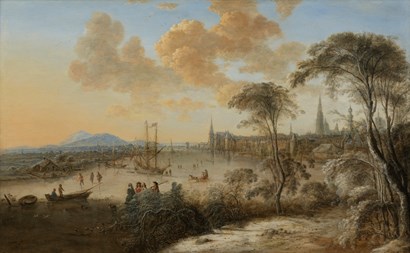
COLNAGHI
Gillis Neyts (Ghent 1623-1687 Antwerp) A winter cityscape of Antwerp, 1666 Oil on panel 54 x 86 cm Signed and dated lower left: g. nyts. f. / 1666 Provenance: sale Fievez, Brussels (16 June 1931), lot 113; sale of the F. Stuyck collection, Brussels, Palais des Beaux-Arts (7-8 December 1960), lot 91; Galerie P. de Boer, Amsterdam (1961) n° 54; Laboratoria Tupens, Sint-Niklaas (?); with Rafael Valls, London; with De Jonckheere, from whom acquired by the present owner Literature: P. Gustot, Gillis Neyts. Un paysagiste brabançon en vallée mosane au XVIIe siècle, Namur, 2008, p. 69, n° P13, repr. Exhibition: Brussels, Musées Royaux des Beaux-Arts de Belgique, Le siècle de Rubens, 15 October-12 December 1965, n° 157, repr.
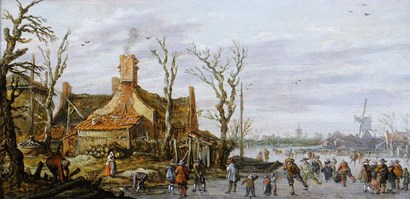
Floris van Wanroij Fine Art
jan josefsz. van goyen
Jan Josefsz. van Goyen (Leiden 1596-1656 The Hague) Winter landscape with skaters, elegant figures and kolf players on the ice in a village Oil on panel 13.6 x 26.8 cm Signed and indistinctly dated lower left ‘I.V. GOYEN. 162.‘ Provenance: anonymous sale, Drouot, Paris, 21 March 1874, lot 23 (Frs. 510), erroneously as a pendant to the consecutive lot; collection Comte de Camondo, Galerie Georges Petit, Paris, 1 February 1893, Lot 6 (Frs. 1.700), were acquired by W. Gretor; anonymous sale, Drouot, Paris, 18 February 1895, Lot 13 (Frs. 750), were acquired by Lange; collection G. Forbes, London (according to Dayot and Hofstede de Groot); sale Jules Cronier, Galerie Georges Petit, Paris, 11 March 1908, Lot 88 (Frs. 1,200); with Kleinberger, Paris; collection Eugène Max, Paris, from 1911 to 1927; Grange, Paris; private collection, Paris, from 1965; anonymous sale, Sotheby’s, London, 1 March 1992, lot 36 (£ 101,200); John Mitchell, London, from 1993; anonymous sale, Christie’s, Amsterdam, 20 November 2012, lot nr. 68 (211.000 Euro); Johnny van Haeften Ltd., London, from 2014 (ref. VP4577), acquired from the previous owner; private collection, The Netherlands Literature: Dayot, A. (1911), Grands & petits maîtres hollandais, exhibition publication, Paris, n° 42; Martin, W. (1918), Alt-Holländische Bilder, Berlin, p. 51, fig. 25; Hofstede de Groot, C. (1927), A catalogue raisonné of the works of the most eminent Dutch painters of the seventeenth century, London, Vol. VIII, p. 294, n° 1170; Beck, H.-U. (1972), Jan van Goyen 1597-1656, Amsterdam, Vol. II, p. 46, n° 88 (illustrated, erroneously as a pendant to n° 244) Exhibitions: Paris, Salle du Jeu de Paume, Grands & petits maîtres hollandais, 28 April-10 July 1911, n° 40 bis; TEFAF Maastricht, 2014

Galeria Bessa Pereira
Carlo Hauner (Brescia 1927-1996 Salina) & Martin Eisler (Vienna 1913-1977 São Paulo) Coffee table, 1960s Jacarandá wood and glass H 46 cm - Ø 89 cm Origin: Brasil Provenance: private collection, Rio de Janeiro; Galeria Bessa Pereira collection, 2025 Literature: Vicente, A., & Vasconcellos, M. (Comps.), Móvel moderno brasileiro (1st edition), São Paulo: Olhares, 2017, p. 231

Objects With Narratives
ben storms
Ben Storms (Ghent, 1983) Ex Hale coffee table, 2024 Miel onyx H 32 x W 180 x D 90 cm Provenance: the artist's studio Ex Hale is a marble table that mimics the shape of a monumental cushion, resulting from a transformation of materials. Two metal sheets are blown up with the same technique that Ben Storms first used for his In Vein and In Hale tables. The resulting cushion shape is then scanned in 3D, after which a CNC machine mills the same shape from a block of marble. Ex Hale plays with our common notions of materiality: the hard stone looks soft instead, an impression that is further enhanced by the delicate surface treatment.

Galerie Flak
Hemba ancestor figure Singiti (commemorative portrait of a chief) Democratic Republic of Congo-Upper Congo River 19th century or early 20th century Carved wood H 86.5 cm Provenance: Mia van Bussel collection, Amsterdam; Kevin Conru collection, Brussels; Adrian Schlag collection, Brussels; Guilhem Montagut collection, Barcelona Literature: Lexikon der Afrikanischen Kunst, Karl-Ferdinand Schaedler, Munich, 1994, p. 242
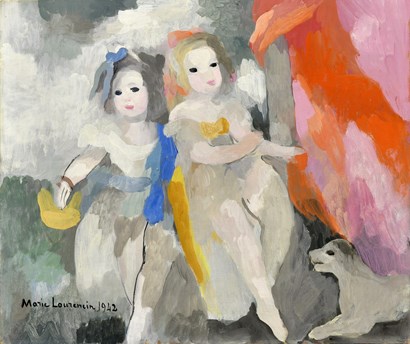
Galerie Taménaga
marie laurencin
Marie Laurencin (Paris, 1883-1956) Deux fillettes et chien, 1942 Oil on canvas 46 x 55 cm Signed and dated lower left 'Marie Laurencin 1942' Provenance: private collection Literature: Beaux-Arts, Paris, 24-30 July 1952; Daniel Marchesseau, Marie Laurencin, Catalogue raisonné de l'œuvre peint, Tokyo: Marie Laurencin Museum, 1986, vol. I, n° 804, repr. p. 327

Galerie Cento Anni
andré lanskoy
André Lanskoy (Moscow 1903-1976 Paris) Un cas suspect, 1964 Oil on canvas 97 x 146 cm Signed and dated 'Lanskoy 64' Provenance: Galerie de Seine; private collection, Paris Certificate of authenticity from the Comité Lanskoy dated 4 April 2025 This work will be included in the forthcoming catalogue raisonné currently in preparation





 NEWSLETTER
NEWSLETTER



